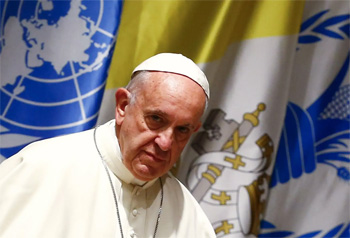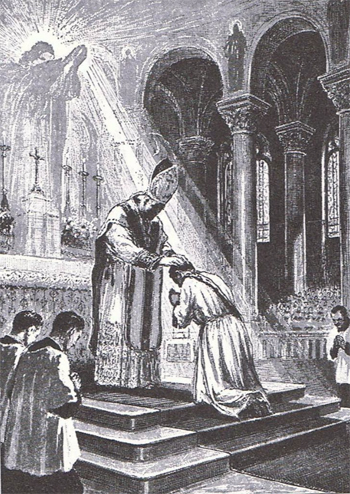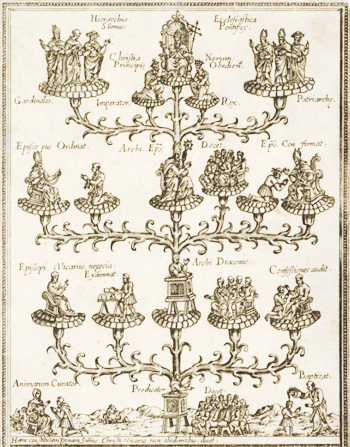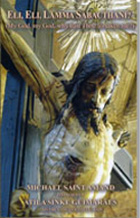Traditionalist Issues
 |
 |
 |
 |
 |
 |
 |
Dialogue Mass - CXXVI
Remaking the Church in
the Image & Likeness of the World
We have already seen how the monarchical structure of the Church’s Constitution was overturned at Vatican II. Fr. Tyrrell spearheaded the revolution and Pope Francis was instrumental in bringing it to full fruition. A key component of their work was the undermining of papal supremacy and its replacement by a system of democratic power-sharing.
Francis, of course, continues the work of the early Modernists and his Conciliar predecessors in deflating the stature of the Papacy to a democratic level; he stated, for example, that he is “in the Church as one baptized” among the baptized, and “in the College of Bishops as a Bishop among Bishops.” (1) He also claims no more than “a primacy of honor for the Bishop of Rome.” (How many today know that this designation was favored by Fr. Tyrrell?) It is, however, only a courtesy title and is commonly understood as the “first among equals,” such as that enjoyed by political leaders in a democratic country. It applies, for instance, to the British Prime Minister who is leader of a Cabinet rather than holding an office that is superior to that of his Ministers. This redefinition of the Petrine Ministry has long been acceptable to Protestants and Schismatics. But any mention of the Catholic doctrine of papal supremacy immediately raises hackles as an obstacle to ecumenical “dialogue.”
 Both Tyrrell and Francis are united in thinking that for the Church to become a democratic society, it must be decentralized, with executive power given to the people. Fr. Tyrrell stated:
Both Tyrrell and Francis are united in thinking that for the Church to become a democratic society, it must be decentralized, with executive power given to the people. Fr. Tyrrell stated:
“Active co-operation in, and responsibility for, the corporate life are what constitute personality and citizenship. Of such responsibility and co-operation, the laity, then the lower clergy, finally the Bishops themselves, have been deprived by a system of centralisation that leaves the Pope the sole and only responsible personality in the Church ‒ or rather, outside and above it. The fruit is that utter decay of interest in the welfare of the body on the part of its passive and irresponsible members.” (2)
Progressivist reformers decry the “passivity” of the laity and demand the participation of all the faithful in the mission of the Church, as a consequence of the neo-modernist teaching of Vatican II. Subsequently, the Conciliar Popes – who have a moral duty to uphold Tradition and show the neo-modernists that their heresies will be fought and defeated – have been appeasing the anti-clericalist mobs.
Tyrrell & Francis debase the priesthood
Here the influence of Fr. Tyrrell is paramount:
“The abuse known as “sacerdotalism” rises from the attribution to officials of a certain spiritual superiority merely in virtue of their office, as though the value of those acts they perform, merely in the name and through the power of the whole Church, derived from some inherent quality of their souls raising them above the laity in spiritual dignity.” (3)
This kind of thinking has heavily impacted on the current identity crisis of the Catholic priesthood since Vatican II, and is in no small part the result of the progressivist denial of a fundamental “character” impressed on the soul of a priest at his ordination. Evidence abounds to demonstrate that this understanding of priestly identity is no longer generally acknowledged. What Fr. Tyrrell and all modernists refused to believe is that the effect of the Sacrament of Ordination – namely, to configure the priest to Christ the Head of the Church – ipso facto raises him in spiritual dignity above the laity. In Evangelii gaudium Pope Francis joined in the chorus of modernist denial:
“The configuration of the priest to Christ the head – namely, as the principal source of grace – does not imply an exaltation which would set him above others. In the Church, functions do not favor the superiority of some vis-à-vis the others.” (4)
 The fundamental error in this passage lies in not acknowledging the supernatural nature, of the priesthood, and in reducing it to a merely human and functional level, as representing one role – and emphatically not a superior one – among many in the Church.
The fundamental error in this passage lies in not acknowledging the supernatural nature, of the priesthood, and in reducing it to a merely human and functional level, as representing one role – and emphatically not a superior one – among many in the Church.
This was exactly Tyrrell’s approach, and was further endorsed by Francis in the same paragraph:
“The ministerial priesthood is [only] one means employed by Jesus for the service of his people, yet our great dignity derives from Baptism, which is accessible to all.”
Tellingly, no mention is made of the infinitely greater dignity of the priest which comes from the power he has received in the Sacrament of Ordination to effect Transubstantiation, as well as his power to forgive sins.
In the new paradigm of the priesthood, the unique status of the priest as a representative of Christ the High Priest is placed on a par with the multifarious “ministries” performed by lay people. That is how the ministerial priesthood since Vatican II has been sidelined as deserving of no special reverence and swallowed up within a generic “great dignity” attached to all the baptized.
Francis takes up the same theme as Tyrrell:
“In virtue of their Baptism, all the members of the People of God have become missionary disciples (cf. Mt 28:19). All the baptized, whatever their position in the Church or their level of instruction in the Faith, are agents of evangelization, and it would be insufficient to envisage a plan of evangelization to be carried out by professionals while the rest of the faithful would simply be passive recipients.” (5)
Francis expressed his opinion loud and clear that lay people have been denied access to executive roles in the Church because “room has not been made for them to speak and to act, due to an excessive clericalism which keeps them away from decision-making.” (6)
This is an obvious attack on the Church’s bi-millennial tradition, prescribed in the 1917 Code of Canon Law, that the ecclesiastical offices and power of governance were reserved “only to clerics.” (Canon 118)
 As a result of Vatican II’s rejection of this tradition which, it is now believed, is an injustice to the rights of the laity, Fr. Tyrrell’s vision of the Church as “one self-teaching, self-governing organism” (7) is being realized before our eyes. Pope Francis takes up the same theme, investing it with an emotionally-charged narrative about lay victimhood at the hands of an exploiting clergy:
As a result of Vatican II’s rejection of this tradition which, it is now believed, is an injustice to the rights of the laity, Fr. Tyrrell’s vision of the Church as “one self-teaching, self-governing organism” (7) is being realized before our eyes. Pope Francis takes up the same theme, investing it with an emotionally-charged narrative about lay victimhood at the hands of an exploiting clergy:
“There is that spirit of clericalism in the Church, that we feel: clerics feel superior; clerics distance themselves from the people. Clerics always say: ‘this should be done like this, like this, like this, and you – go away!’ It happens when the cleric doesn’t have time to listen to those who are suffering, the poor, the sick, the imprisoned: the evil of clericalism is a really awful thing; it is a new edition of this ancient evil [of the religious authorities lording it over others]. But the victim is the same: the poor and humble people, who await the Lord.” (8)
It is patently obvious from the Marxist-inspired tenor of this anti-clerical caricature that Francis is undermining the foundation of his own Papacy, which rests on the authority he has received to rule the Church.
Continued

Francis, of course, continues the work of the early Modernists and his Conciliar predecessors in deflating the stature of the Papacy to a democratic level; he stated, for example, that he is “in the Church as one baptized” among the baptized, and “in the College of Bishops as a Bishop among Bishops.” (1) He also claims no more than “a primacy of honor for the Bishop of Rome.” (How many today know that this designation was favored by Fr. Tyrrell?) It is, however, only a courtesy title and is commonly understood as the “first among equals,” such as that enjoyed by political leaders in a democratic country. It applies, for instance, to the British Prime Minister who is leader of a Cabinet rather than holding an office that is superior to that of his Ministers. This redefinition of the Petrine Ministry has long been acceptable to Protestants and Schismatics. But any mention of the Catholic doctrine of papal supremacy immediately raises hackles as an obstacle to ecumenical “dialogue.”

Democracy’s Pope
“Active co-operation in, and responsibility for, the corporate life are what constitute personality and citizenship. Of such responsibility and co-operation, the laity, then the lower clergy, finally the Bishops themselves, have been deprived by a system of centralisation that leaves the Pope the sole and only responsible personality in the Church ‒ or rather, outside and above it. The fruit is that utter decay of interest in the welfare of the body on the part of its passive and irresponsible members.” (2)
Progressivist reformers decry the “passivity” of the laity and demand the participation of all the faithful in the mission of the Church, as a consequence of the neo-modernist teaching of Vatican II. Subsequently, the Conciliar Popes – who have a moral duty to uphold Tradition and show the neo-modernists that their heresies will be fought and defeated – have been appeasing the anti-clericalist mobs.
Tyrrell & Francis debase the priesthood
Here the influence of Fr. Tyrrell is paramount:
“The abuse known as “sacerdotalism” rises from the attribution to officials of a certain spiritual superiority merely in virtue of their office, as though the value of those acts they perform, merely in the name and through the power of the whole Church, derived from some inherent quality of their souls raising them above the laity in spiritual dignity.” (3)
This kind of thinking has heavily impacted on the current identity crisis of the Catholic priesthood since Vatican II, and is in no small part the result of the progressivist denial of a fundamental “character” impressed on the soul of a priest at his ordination. Evidence abounds to demonstrate that this understanding of priestly identity is no longer generally acknowledged. What Fr. Tyrrell and all modernists refused to believe is that the effect of the Sacrament of Ordination – namely, to configure the priest to Christ the Head of the Church – ipso facto raises him in spiritual dignity above the laity. In Evangelii gaudium Pope Francis joined in the chorus of modernist denial:
“The configuration of the priest to Christ the head – namely, as the principal source of grace – does not imply an exaltation which would set him above others. In the Church, functions do not favor the superiority of some vis-à-vis the others.” (4)

The priest is sacred & divinely ordained
This was exactly Tyrrell’s approach, and was further endorsed by Francis in the same paragraph:
“The ministerial priesthood is [only] one means employed by Jesus for the service of his people, yet our great dignity derives from Baptism, which is accessible to all.”
Tellingly, no mention is made of the infinitely greater dignity of the priest which comes from the power he has received in the Sacrament of Ordination to effect Transubstantiation, as well as his power to forgive sins.
In the new paradigm of the priesthood, the unique status of the priest as a representative of Christ the High Priest is placed on a par with the multifarious “ministries” performed by lay people. That is how the ministerial priesthood since Vatican II has been sidelined as deserving of no special reverence and swallowed up within a generic “great dignity” attached to all the baptized.
Francis takes up the same theme as Tyrrell:
“In virtue of their Baptism, all the members of the People of God have become missionary disciples (cf. Mt 28:19). All the baptized, whatever their position in the Church or their level of instruction in the Faith, are agents of evangelization, and it would be insufficient to envisage a plan of evangelization to be carried out by professionals while the rest of the faithful would simply be passive recipients.” (5)
Francis expressed his opinion loud and clear that lay people have been denied access to executive roles in the Church because “room has not been made for them to speak and to act, due to an excessive clericalism which keeps them away from decision-making.” (6)
This is an obvious attack on the Church’s bi-millennial tradition, prescribed in the 1917 Code of Canon Law, that the ecclesiastical offices and power of governance were reserved “only to clerics.” (Canon 118)

A hierarchy going back thousands of years
“There is that spirit of clericalism in the Church, that we feel: clerics feel superior; clerics distance themselves from the people. Clerics always say: ‘this should be done like this, like this, like this, and you – go away!’ It happens when the cleric doesn’t have time to listen to those who are suffering, the poor, the sick, the imprisoned: the evil of clericalism is a really awful thing; it is a new edition of this ancient evil [of the religious authorities lording it over others]. But the victim is the same: the poor and humble people, who await the Lord.” (8)
It is patently obvious from the Marxist-inspired tenor of this anti-clerical caricature that Francis is undermining the foundation of his own Papacy, which rests on the authority he has received to rule the Church.
Continued
- Francis, Discourse at the Commemoration of 50th Anniversary of the Institution of the Synod of Bishops, October 17, 2015.
- G. Tyrrell, Medievalism, p. 102.
- Tyrrell, The Church and the Future, pp. 133-134.
- Francis, Evangelii gaudium, 2013, § 104.
- Ibid., § 120
- Ibid., § 102.
- G. Tyrrell, “Lord Halifax Demurs,” The Weekly Register, n. 2680, May 3, 1901, p. 550, apud David Wells, The Prophetic Theology of George Tyrrell, Chico, CA: Scholars Press, 1979, p. 49.
- Francis, “People Discarded,” Homily in Casa Santa Maria, December 13, 2016.
Posted May 8, 2023

______________________
______________________
 Volume I |
 Volume II |
 Volume III |
 Volume IV |
 Volume V |
 Volume VI |
 Volume VII |
 Volume VIII |
 Volume IX |
 Volume X |
 Volume XI |
 Special Edition |


